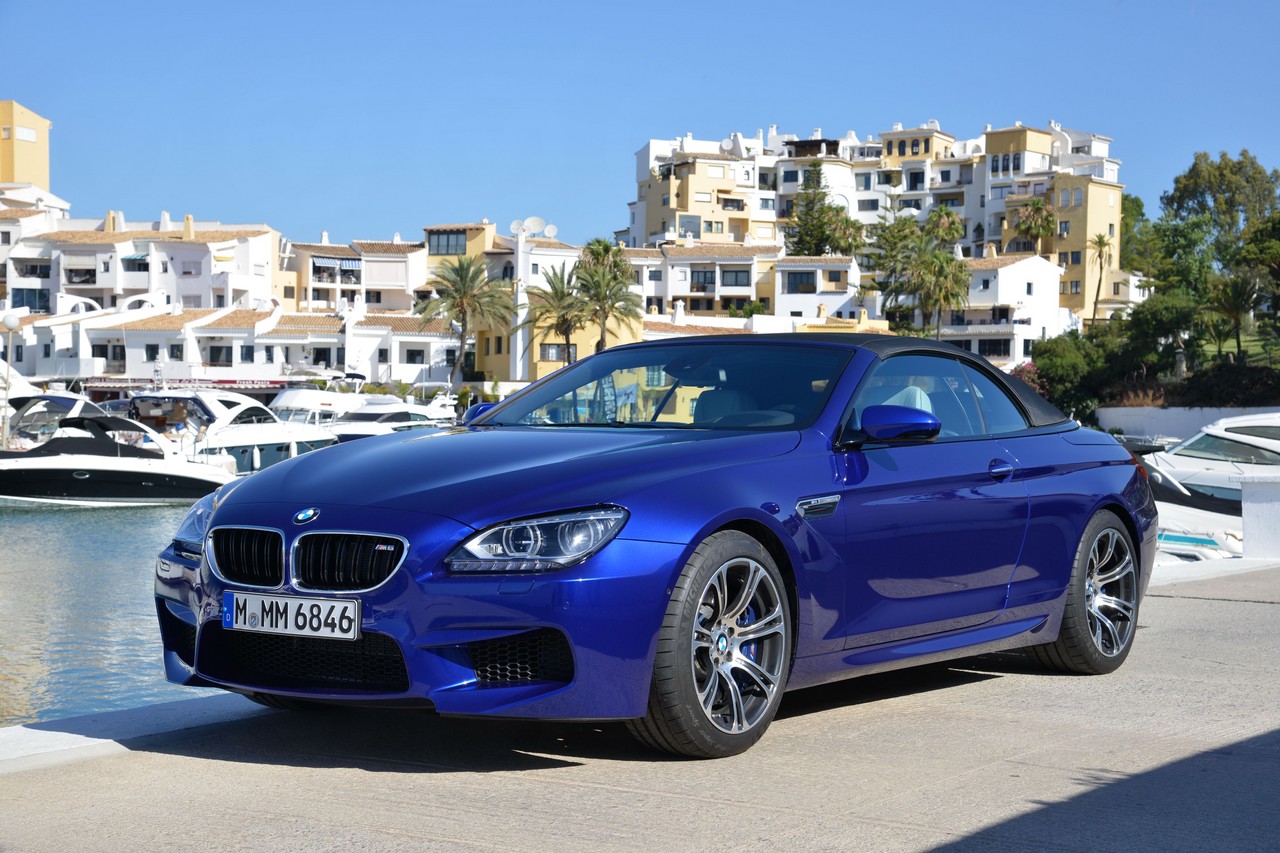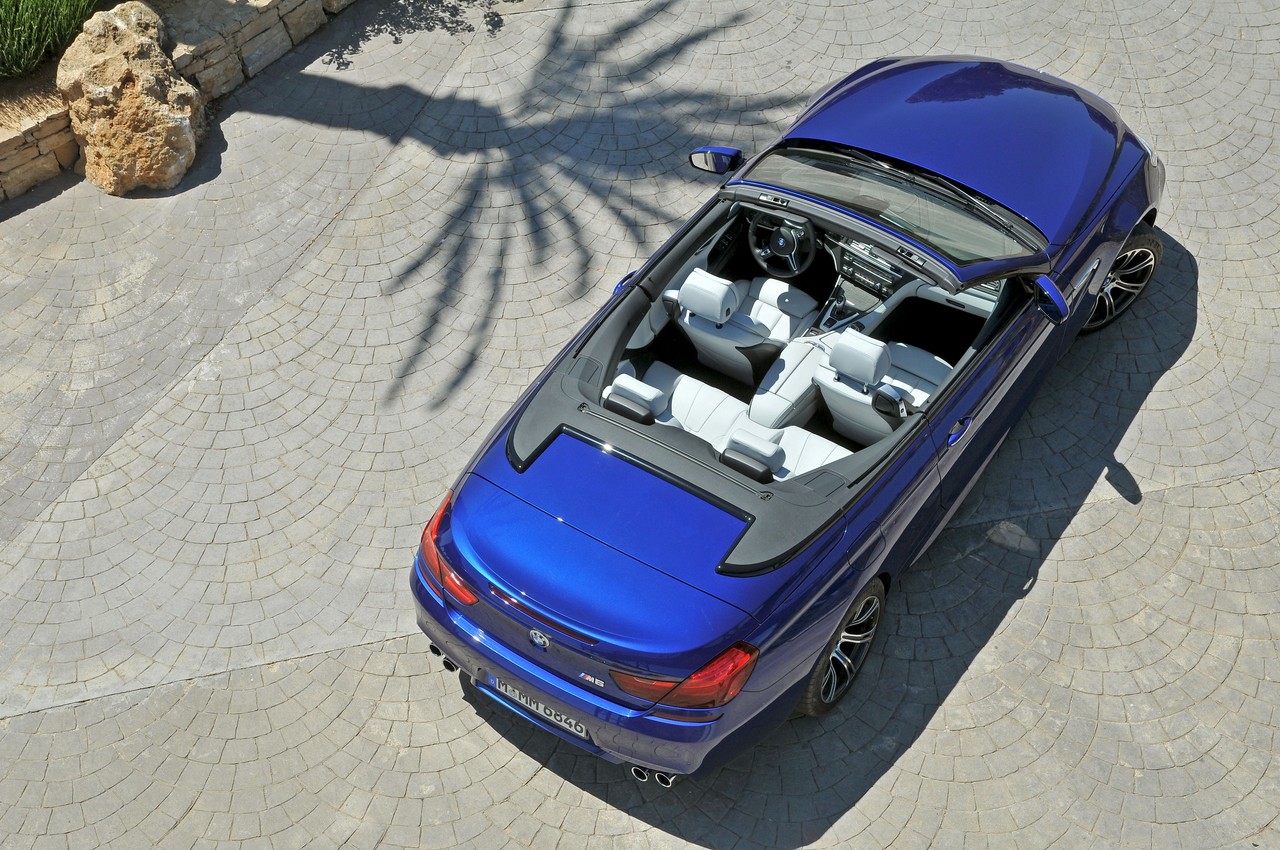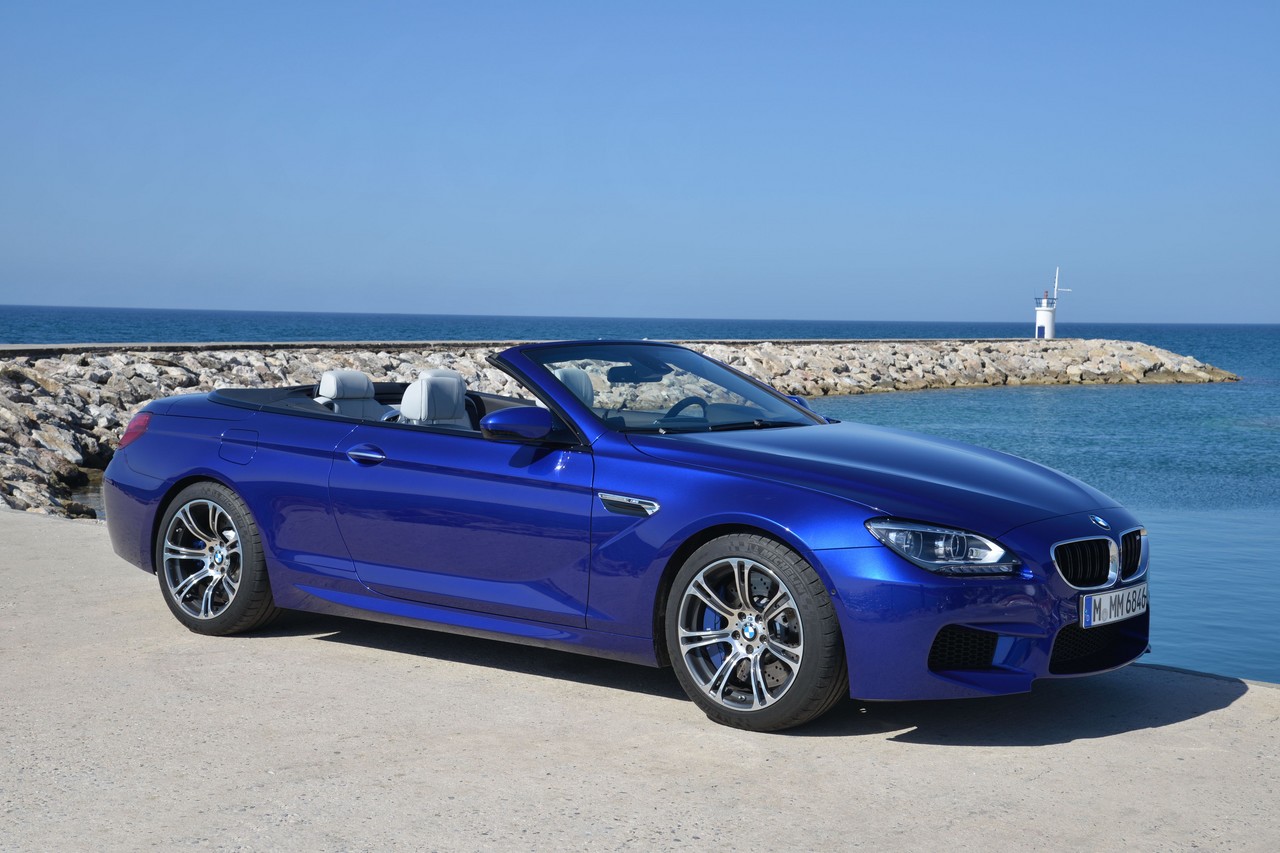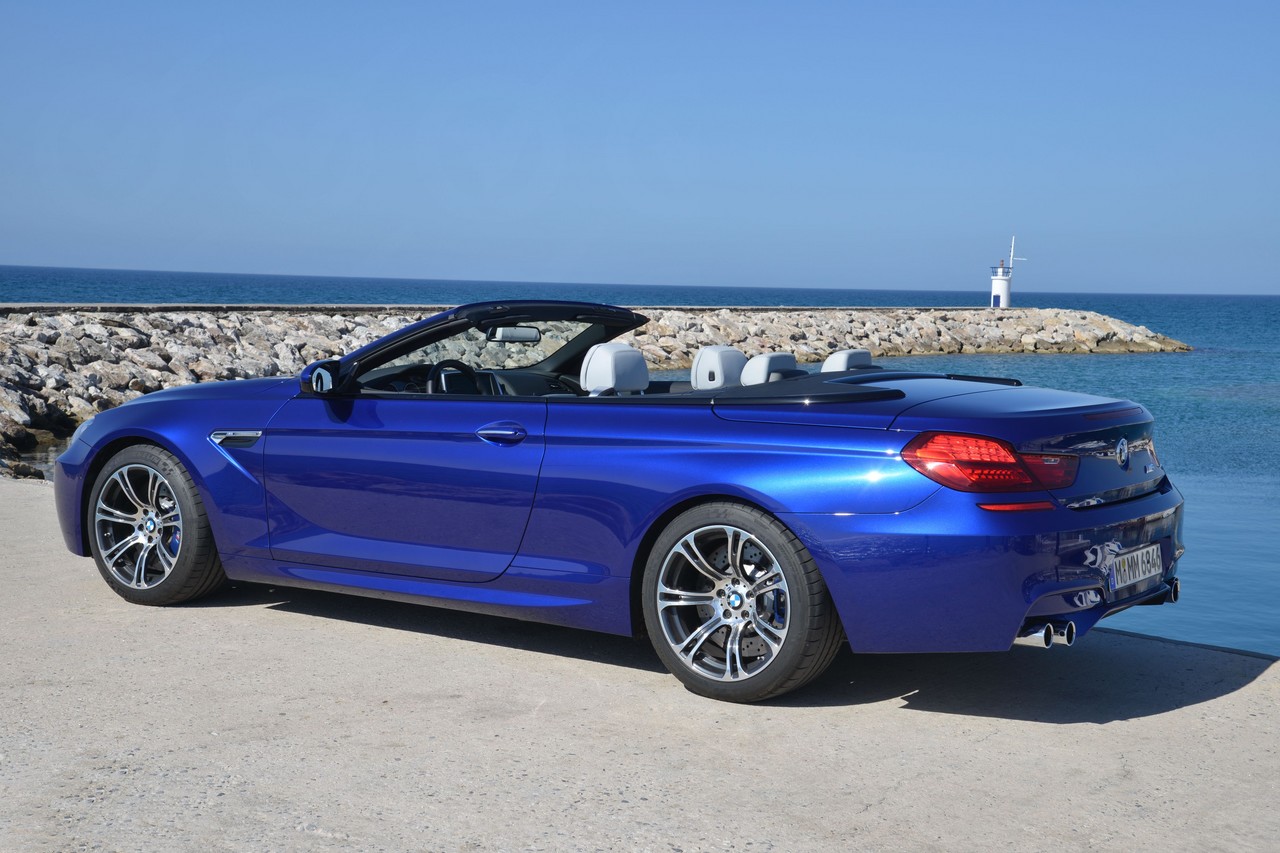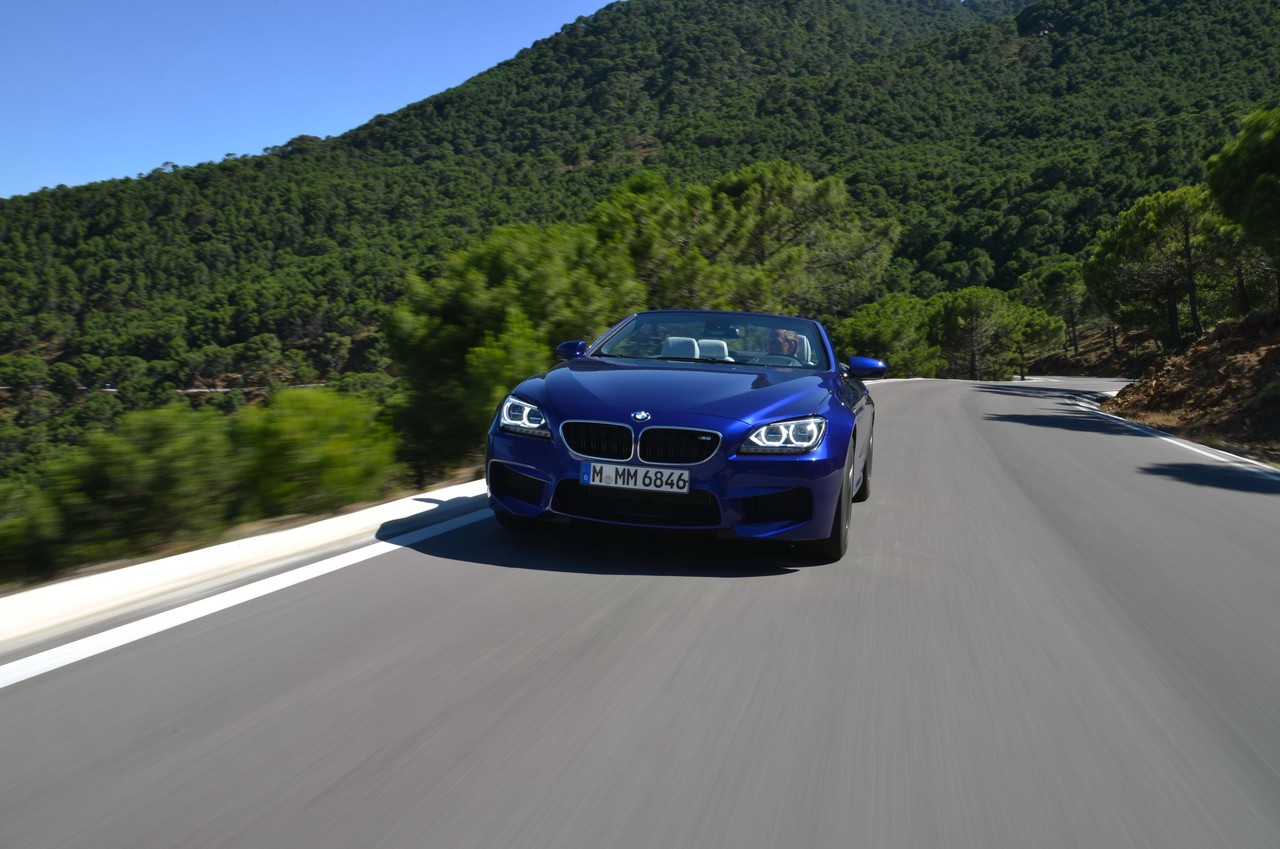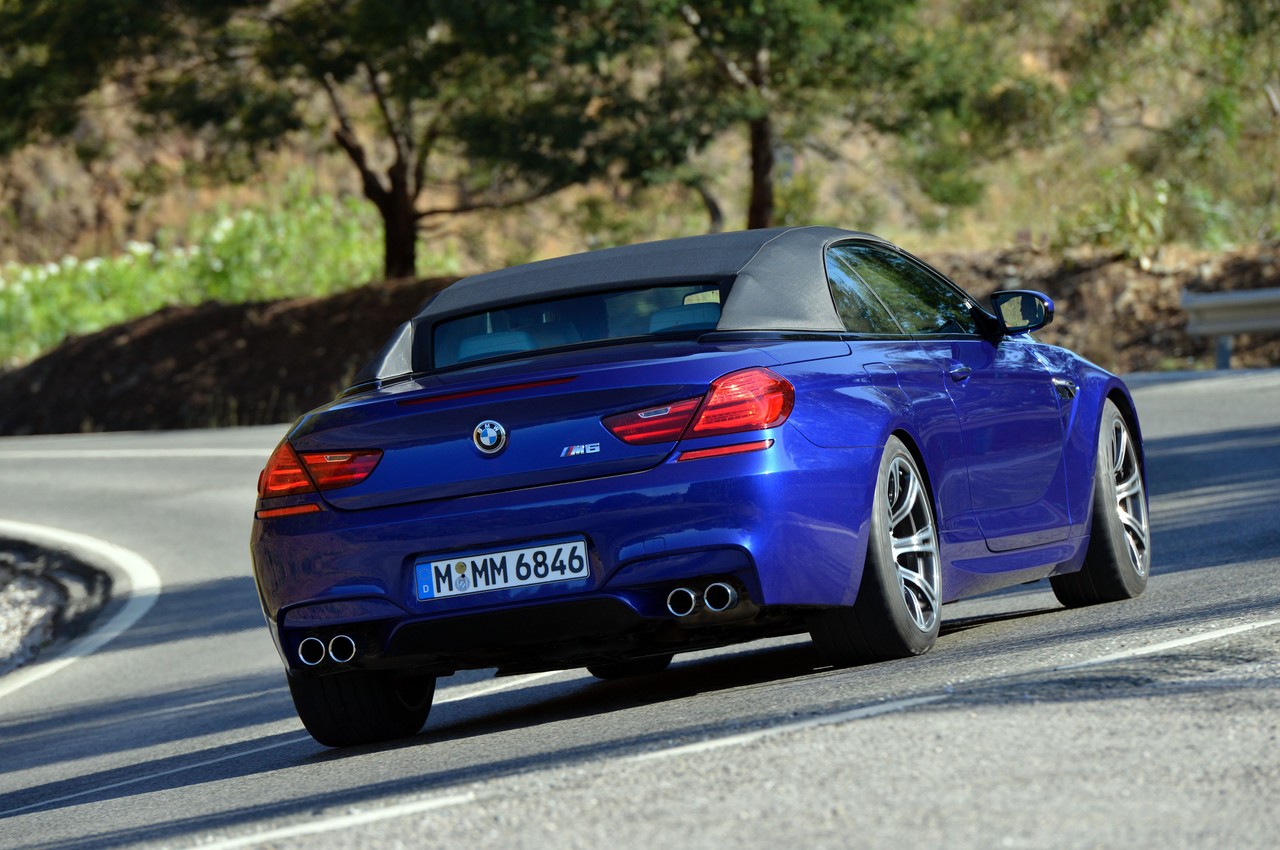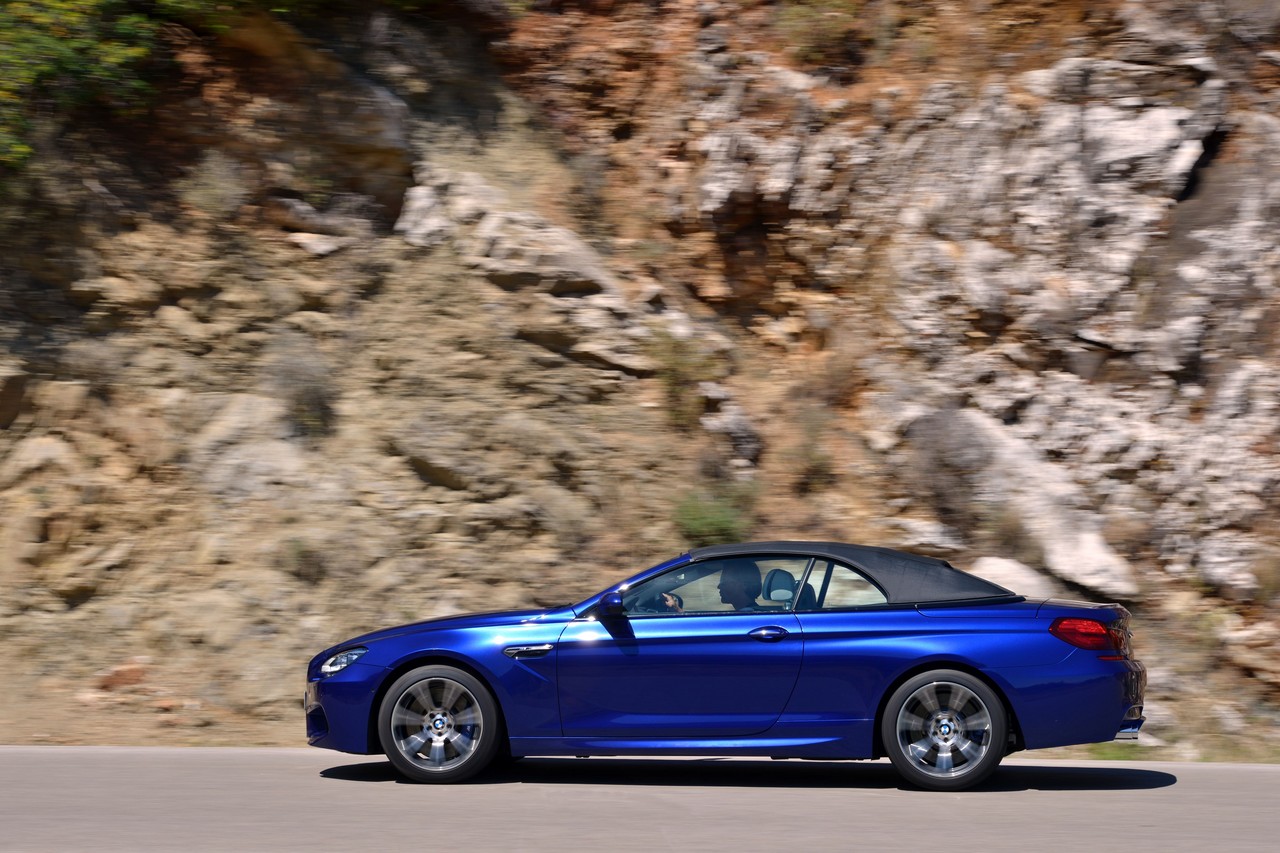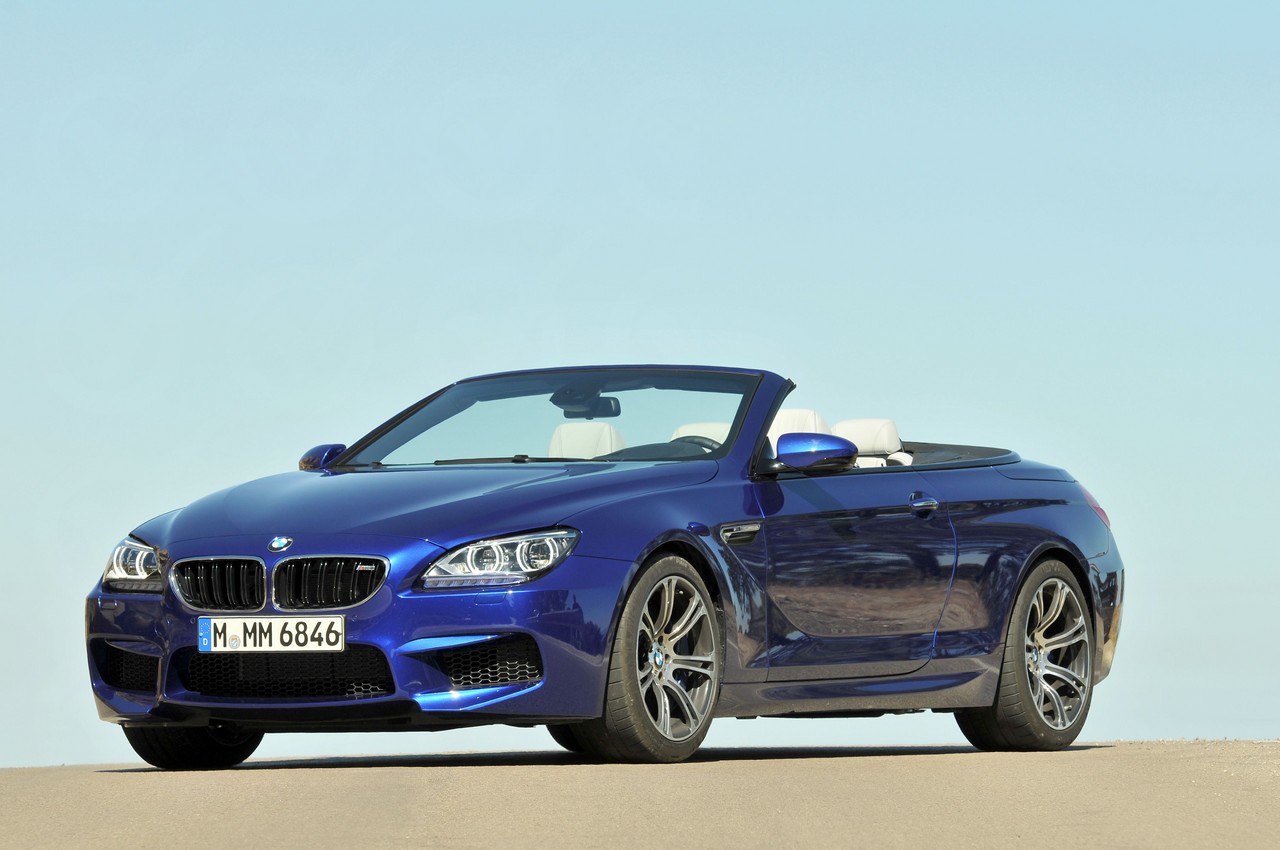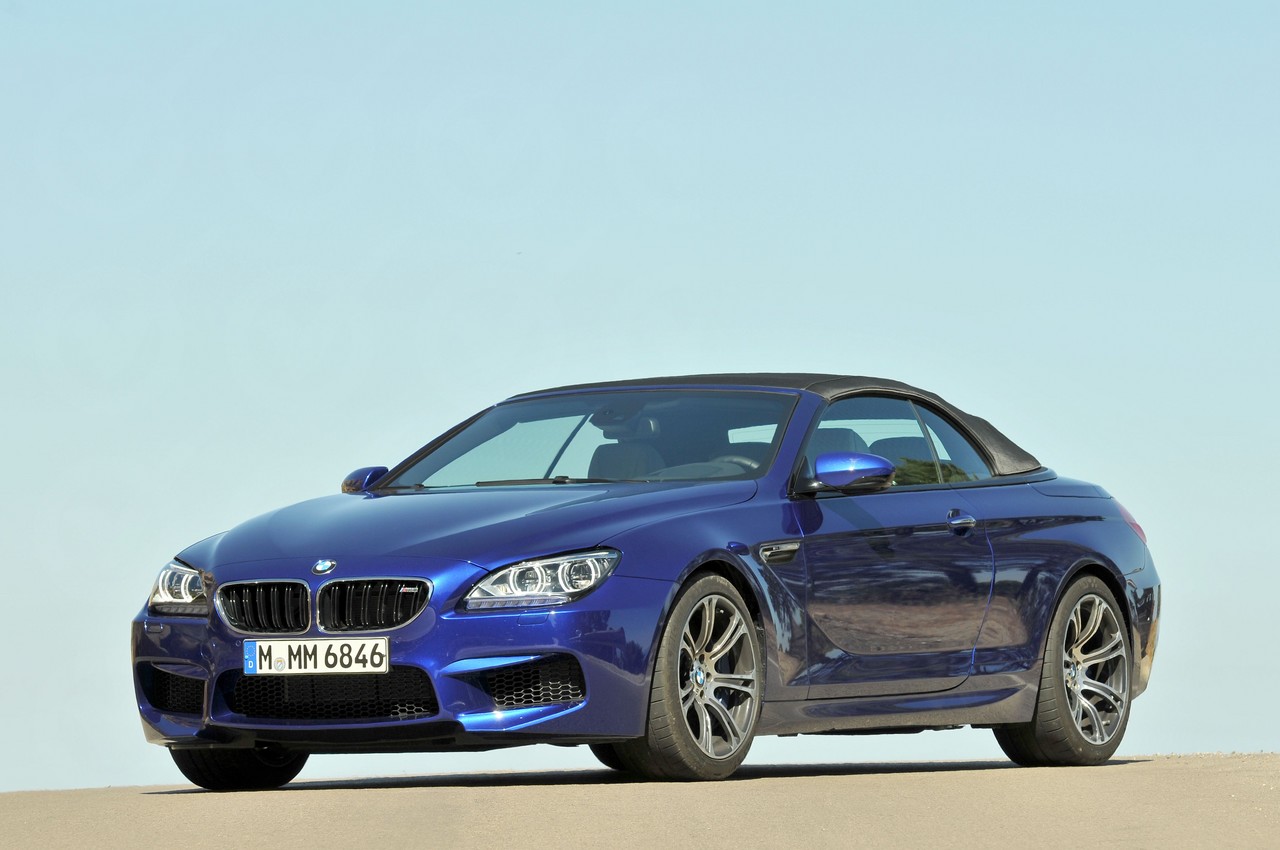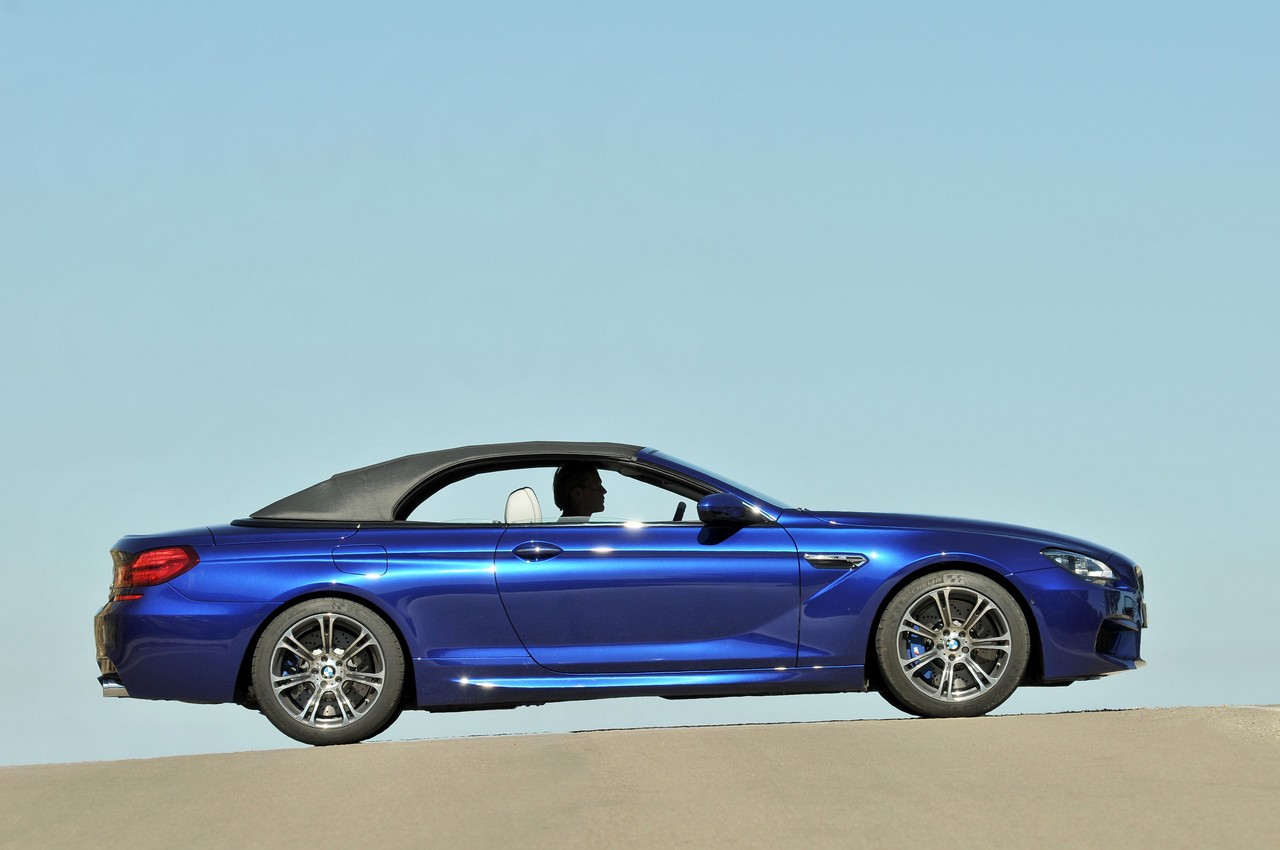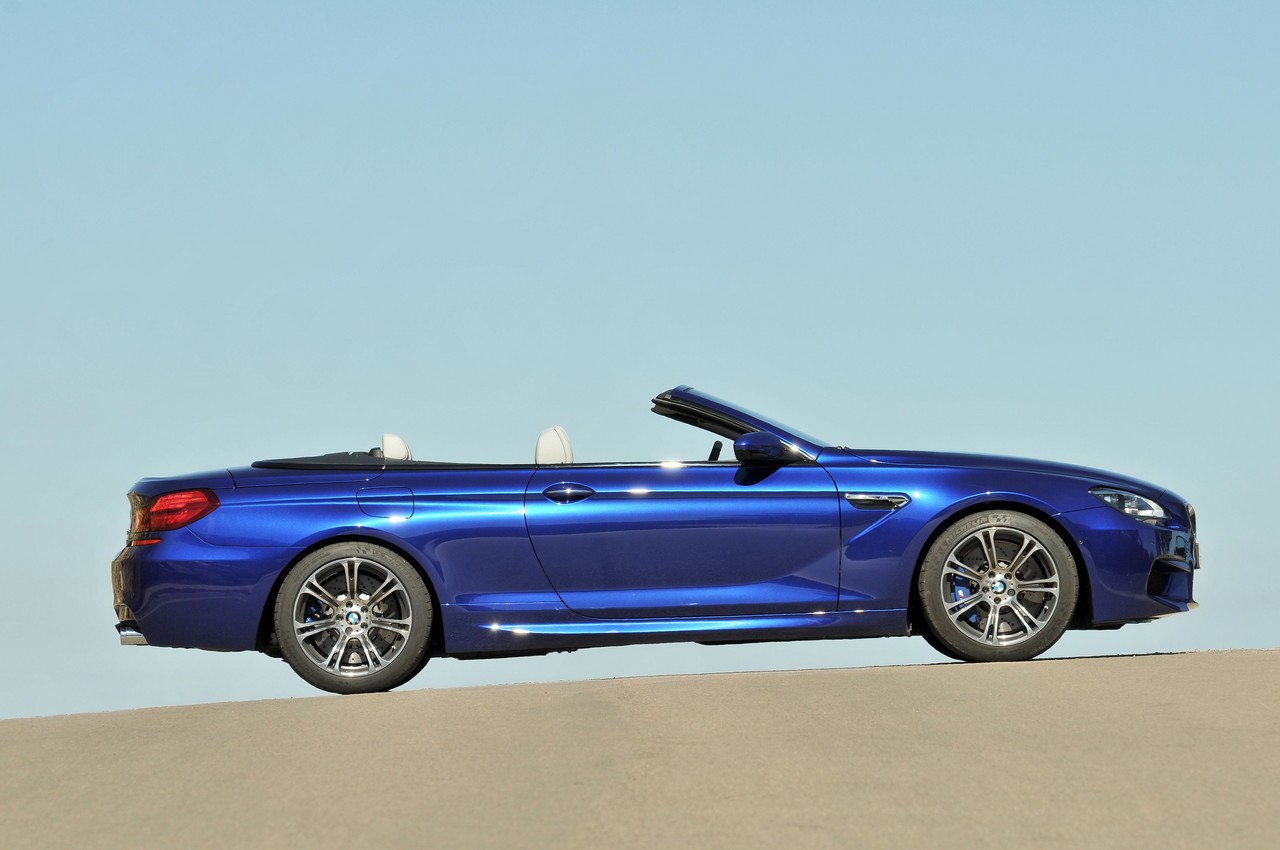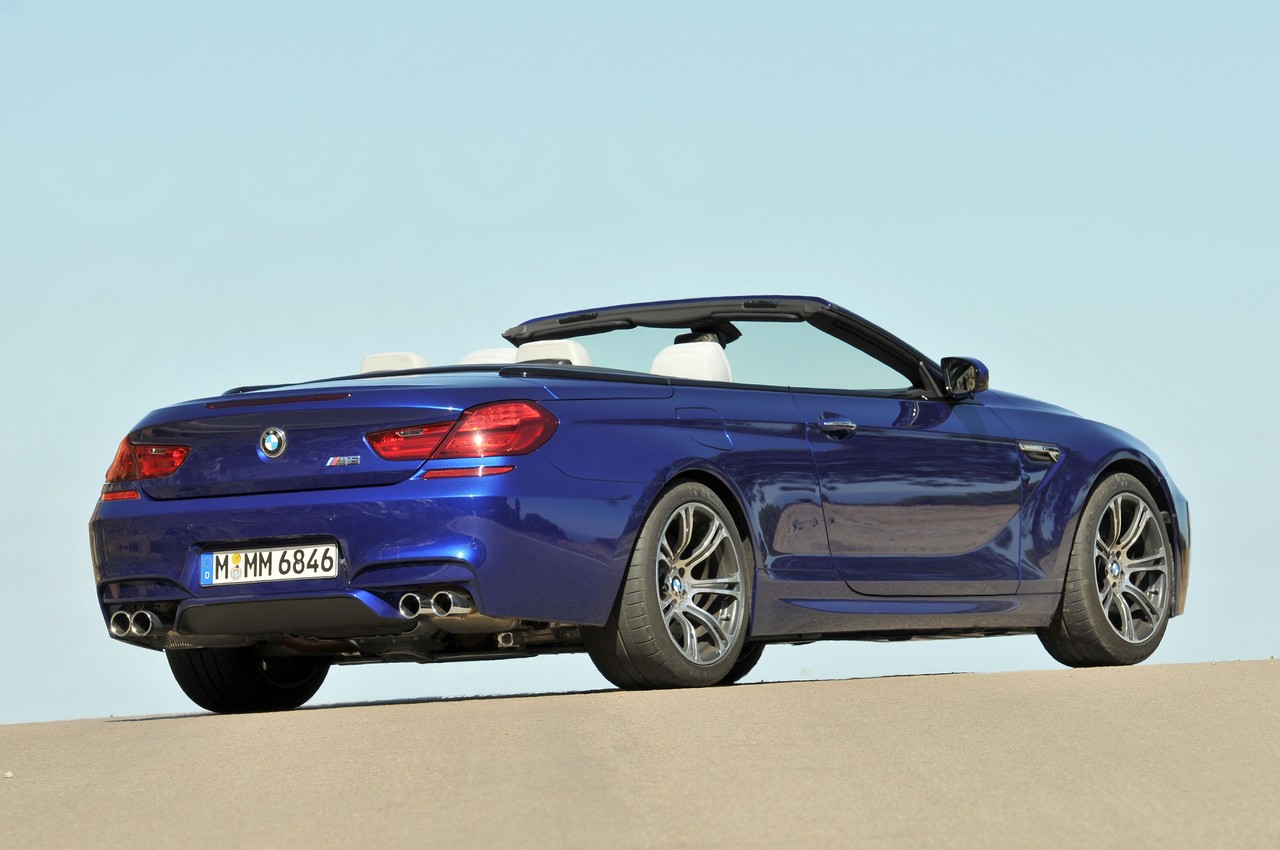
- 4.8-litre twin-turbo V8 provides astonishing, lag-free performance
- Grand Tourer dynamics
- Accurate steering has good feel
- High standard of fit and finish
- Weight blunts agility
- Cramped rear seats
- Disappointing engine note
- High running and maintenance costs
BMW F12.I M6 Convertible (2012-14)
Overview
Released in Australia in November 2012, the BMW F12 M6 was a high-performance, four-seat convertible with a soft-top roof. Manufactured in Dingolfing, Germany, the rear-wheel drive F13 M6 Convertible was powered by a 4.4-litre twin-turbo V8 petrol engine that was mated to a seven-speed double clutch transmission (DCT).
S63B44TU V8 engine
With a closed-deck, aluminium-silicon alloy (Alusil) crankcase produced at BMW’s Landshut light-alloy foundry, the S63B44TU 90-degree V8 engine had an 88.3 mm bores and an 89.0 mm stroke for a capacity of 4395 cc. Shared with the F10 M5 , the S63B44TU featured an aluminium alloy cylinder head, high-precision direct petrol injection (at pressures up to 200 bar), twin-scroll turbochargers providing maximum boost pressure of 1.5 bar, a pulse-tuned exhaust manifold, double overhead camshafts, variable intake and exhaust camshaft timing (double VANOS), four valves per cylinder, BMW’s ‘Valvetronic III’ variable valve control, a compression ratio of 10.0:1, DME MEVD17.2.8 engine management and wet sump lubrication.
The F12 M6 Convertible could accelerate from rest to 100 km/h in 4.3 seconds and to 200 km/h in 13.1 seconds. Over the combined EU test cycle, fuel consumption was 10.3 litres per 100 km. Maximum speed was electronically-limited to 250 km/h. Furthermore, the driver could select from Efficient, Sport and Sport Plus drive modes.
The M6 Convertible was fitted with BMW’s EfficientDynamics technologies which included:
- An ‘Auto Start Stop’ function that enabled the engine to shut down when the vehicle was stationary in traffic; and,
- ‘Brake Energy Regeneration’ which controlled alternator output to charge the battery when the vehicle was braking or coasting.
M Double Clutch Transmission (DCT)
The double clutch transmission (DCT) combined two gearbox components in a common housing and featured two oil-cooled wet clutches. One of the clutches operated the even gears (i.e. 2, 4 and 6), while the other clutch operated the uneven gears (i.e. 1, 3, 5, 7 and reverse). When driving, one of the clutches was always closed and the other open. When up- or down-shifting, the transmission control unit would pre-select the next gear and the clutches would be activated in an alternating process such that one clutch would open just as the other was closing.
The DCT had automated (D) and manual (S) gearshift modes, while the driver could select gears by the gear lever or steering wheel gearshift paddles. Via a rocker switch positioned behind the gear lever, the driver could select three settings:
- D1: smooth gearshifts and maximum fuel efficiency;
- D2: faster gearshifts (accompanied by jolts at higher engine speeds) with gear changes according to engine speed and load; and,
- D3: rapid gearshifts for with gear changes delayed for higher engine speeds.
The DCT also had a Launch Control function and ‘Low Speed Assistance’ function that kept the vehicle moving at low speeds in stop-start traffic.
The gear ratios for the DCT were: 4.806 (1st), 2.593 (2nd), 1.701 (3rd), 1.277 (4th), 1.000 (5th), 0.844 (6th) and 0.671 (7th); the final drive ratio was 3.154:1.
Dimensions and body
Compared to its E64 M6 Convertible predecessor, the F12 M6 Convertible was 27 mm longer (at 4898 mm), 44 mm wider (1899 mm), 5 mm lower (1372 mm) and had a 70 mm longer wheelbase (2851 mm); unladen weight increased by 50 kg to 2055 kg (EU). Relative to the F12 6-Series Convertible , track width for the M6 Convertible was increased by 30 mm for a front track of 1631 mm and rear track of 1612 mm; the increased track was accommodated by flared front wheel arches.
The F12 M6 Convertible had a heated, vertical glass rear window which could retract independently of the power-operated soft-top roof. The soft-top roof could be operated while driving at speeds of up to 40 km/h and could in 19 seconds, or be raised in 24 second. Furthermore, boot capacity was 350 litres with the roof up and 300 litres with it open.
With its roof up, the M6 Convertible had a drag coefficient of 0.33 Cd.
Suspension
The F12 M6 Convertible had double wishbone front suspension and an integral-V multi-arm rear suspension. As standard, the suspension included BMW’s ‘Dynamic Damper Control’ which used electronically-controlled valves within the dampers to react to vertical movement of the wheels. As a result, the electronically-controlled dampers continually adjusted to road conditions; the driver could select from Comfort, Sport and Sport+ settings.
Steering
The F12 M6 Convertible had variable ratio, hydraulic rack-and-pinion steering with power assistance (BMW’s ‘Servotronic’) varied according to speed. Furthermore, the driver could select from Comfort, Sport and Sport+ settings which also varied power assistance.
| Engine | Trans. | Peak power | Peak torque | |
|---|---|---|---|---|
| M6 | 4.4-litre twin-turbo petrol V8 (S63 B44TU) | 7sp DCT | 412 kW at 6000-7000 rpm | 680 Nm at 1500-5750 rpm |
Safety equipment
Standard safety equipment for the F12.I M6 Convertible included dual front airbags, front seat-mounted side airbags with head and thorax protection, ABS, electronic brake force distribution, brake assist, electronic stability control, traction control, cornering brake control, active front seat head restraints, front seatbelts with pretensioners and load limiters and an automatically deploying rollover bar. For the stability control system, an M Dynamic Mode (MDM) could be activated which raised wheelspin and yaw thresholds prior to its intervention.
As standard, the M6 was also fitted:
- BMW’s ‘Active Protection’ system which prepared the vehicle if an accident was assessed to be imminent by tensioning the seatbelts and closing the windows. After a collision, autonomous braking would occur to reduce the likelihood of a secondary collision;
- An ‘active bonnet’ which, in the event of a collision with a pedestrian, would use pyrotechnic actuators to raise the level of the bonnet to minimise the severity of the pedestrian’s subsequent impact;
- A Lane Departure Warning system which recognised when the vehicle strayed from its lane and alerted the driver through steering wheel vibrations;
- A Lane Change Warning system which would alert the driver – via steering wheel vibrations and a visual warning on the door mirror – of oncoming vehicles and vehicles in driver’s blind spot when the indicator is activated; and,
- Intelligent Emergency Call: would automatically call the BMW ConnectedDrive Call Center and transmit vehicle accident information. If required, emergency services would then be informed. A manual emergency call could also be initiated via the SOS button
From July 2013 production, standard safety equipment included ‘Forward Collision Warning and Pedestrian Warning with City Braking’ which operated at speeds between 10 and 60 km/h. This system would warn the driver if a pedestrian or stationary vehicle was detected in the vehicle’s path. If the driver failed to react, the system would automatically apply the brakes to prevent or minimise the severity of a collision.
Brakes
The F12 M6 Convertible had 400 mm by 36 mm vented front brake discs with six-piston calipers (radially bolted to the pivot bearing) and 396 mm by 24 mm vented rear discs with single-piston calipers. Furthermore, the braking system included the following functions:
- Brake Drying: to keep the brake pads dry, the brake pad was pressed against the rotor when the rain sensor detected moisture;
- Start-Off Assistant: applied the brakes for one second after the driver’s foot was removed from the brake pedal for uphill acceleration from rest; and,
- Brake Fade Compensation: applied additional braking force when the brakes were hot to compensate for the loss of braking ability that occurred in such situations.
For models with the optional 20-inch alloy wheels, the M6 was available with carbon-ceramic brakes discs that provided greater resistance to heat and significantly reduced rotating masses (by 19.4 kg). For the carbon-ceramic brakes, front disc diameter was increased to 410 mm.
Features: M6 Convertible
Standard features for the F12 M6 Convertible included 19-inch M light-alloy wheels with seven double-spoke styling (BMW’s 343M), 9.5J x 19 265/40 R19 102Y front and 10.5J x 19 295/35 R19 104Y rear tyres,BMW’s iDrive with 9.2-inch display, six disc DVD changer, 20GB hard drive storage, digital TV tuner, Internet connectivity via a pre-fitted SIM card, Bluetooth mobile phone connectivity and audio streaming, a twelve speaker harman/kardon surround sound system with a nine-channel 500 watt amplifier and auxiliary input (USB/iPod), BMW’s ‘Professional’ navigation system with a 10.2-inch display, 3D maps and real-time traffic information, dual-zone climate control air conditioning, full merino leather upholstery, power adjustable and ventilated ‘M’ front sports seats with heating, cruise control with braking function, adaptive LED headlights with High-Beam Assist, rear fog lights, front and rear parking sensors (BMW’s ‘Park Distance Control’), a rear view camera, surround view camera system (including top view and side view), automatic headlights, rain-sensing wipers, M leather-wrapped steering wheel, remote central locking with proximity key (i.e. keyless entry), power windows, power adjustable and heated mirrors, a power adjustable steering column, driver memory settings (for the driver’s seat, mirrors and steering column position), head-up display, electrochromatic rear view mirrors, push-button start, soft-close doors, ambient lighting, a 12 volt power socket, velour floor mats, an alarm and immobiliser.
Active M Differential
Fitted as standard, the Active M Differential was an electronically controlled multi-plate limited-slip differential with variable locking that could apportion power between the right and left rear wheel for maximum traction. The Active M Differential’s control unit was connected via FlexRay high-speed data transfer to the Dynamic Stability Control (DSC) system to calculate the locking force needed – from 0 to 100 per cent – based on throttle position, wheel speed and yaw.
Related links
- Press Kit: BMW F13 M6 Coupe and F12 M6 Convertible (June 2012)
- Press Kit: BMW F12/F13 M6 – Australia (November 2012)
- Specifications: BMW F06, F12 and F13 M6 (April 2014)
BMW F12.II M6 Convertible (2015-18)
Overview
Released in Australia in June 2015, the F12 Series II (F12.II) M6 Convertible was fitted with BMW’s Competition Package as standard; it included:
- More powerful version of BMW’s S63B44 engine, producing 441 kW and 700 Nm;
- Exclusive 20-inch M light alloy wheels;
- Modified suspension, damping and stabiliser configurations;
- Optimised control settings for the rear Active M differential;
- A sports exhaust system with signature M black chrome twin tailpipes;
- More direct steering with M-specific Servotronic function; and,
- A revised M Dynamic Mode.
The interior for the F12.II M6 Convertible featured new high-quality surfaces, a frameless central information display, contrasting stitching and the latest generation BMW Head-Up Display (HUD).
| Engine | Trans. | Years | Peak power | Peak torque | |
|---|---|---|---|---|---|
| M6 Competition Package | 4.4-litre twin-turbo petrol V8 (S63 B44TU) | 7sp DCT | 2015-18 | 441 kW at 6000-7000 rpm | 700 Nm at 1500-6000 rpm |
Features: M6 Convertible
Compared to its F12.I predecessor, standard features for the F12.II M6 Convertible were extended to include DAB+ digital radio, tyre pressure monitoring and a wind deflector.
Related links
